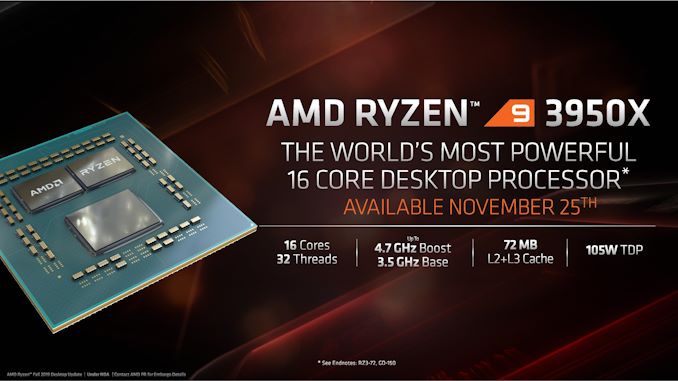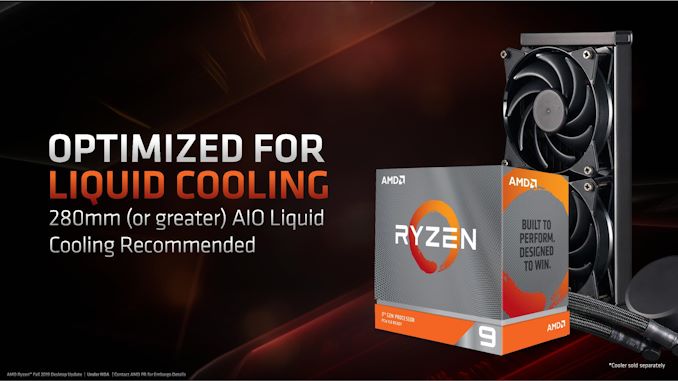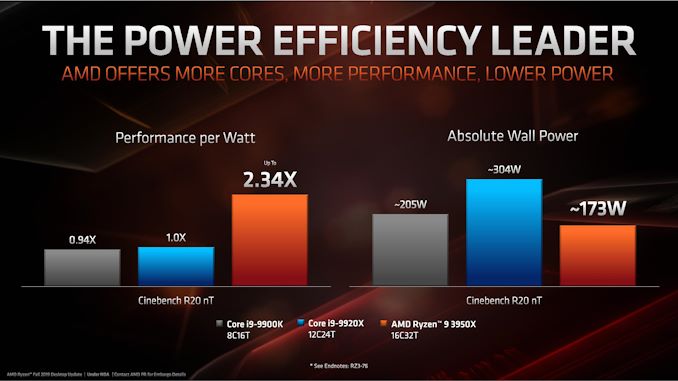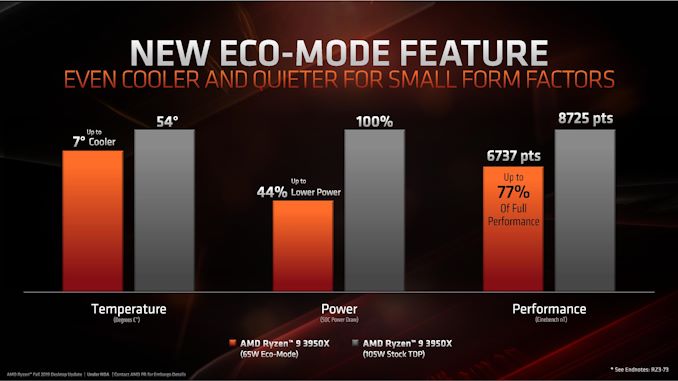AMD Q4: 16-core Ryzen 9 3950X, Threadripper Up To 32-Core 3970X, Coming November 25th
by Dr. Ian Cutress on November 7, 2019 9:00 AM ESTHigh-End Desktop? What’s That?
The Ryzen 9 3950X Comes Into View
As teased at E3 and seemingly every show that AMD has been to since, we’re now ready to get our hands on AMD’s top-tier consumer-grade processor. The Ryzen 9 3950X is the bigger cousin to the Ryzen 9 3900X, this time using two 8-core chiplets built on TSMC’s 7nm process with the Zen 2 microarchitecture. This is paired with the same I/O die, and overall this Ryzen 9 3950X will offer four more cores and +100 MHz on the turbo frequency over the 3900X, all at a $749 recommended retail price point.
| AMD 'Matisse' Ryzen 3000 Series CPUs | |||||||||||
| AnandTech | Cores Threads |
Base Freq |
Boost Freq |
L2 Cache |
L3 Cache |
PCIe 4.0 |
Chiplets IO+CPU |
TDP | Price (SEP) |
||
| Ryzen 9 | 3950X | 16C | 32T | 3.5 | 4.7 | 8 MB | 64 MB | 16+4+4 | 1+2 | 105W | $749 |
| Ryzen 9 | 3900X | 12C | 24T | 3.8 | 4.6 | 6 MB | 64 MB | 16+4+4 | 1+2 | 105W | $499 |
| Ryzen 9 | 3900 | 12C | 24T | 3.1 | 4.3 | 6 MB | 64 MB | 16+4+4 | 1+2 | 65W | OEM |
| Ryzen 7 | 3800X | 8C | 16T | 3.9 | 4.5 | 4 MB | 32 MB | 16+4+4 | 1+1 | 105W | $399 |
| Ryzen 7 | 3700X | 8C | 16T | 3.6 | 4.4 | 4 MB | 32 MB | 16+4+4 | 1+1 | 65W | $329 |
| Ryzen 5 | 3600X | 6C | 12T | 3.8 | 4.4 | 3 MB | 32 MB | 16+4+4 | 1+1 | 95W | $249 |
| Ryzen 5 | 3600 | 6C | 12T | 3.6 | 4.2 | 3 MB | 32 MB | 16+4+4 | 1+1 | 65W | $199 |
| Ryzen 5 | 3500X | 6C | 6T | 3.6 | 4.1 | 3 MB | 32 MB | 16+4+4 | 1+1 | 65W | OEM |
The Ryzen 9 3950X will be compatible in the majority of AM4 motherboards, although in order to take advantage of the 24 PCIe 4.0 lanes on the CPU, an X570 motherboard is recommended. The 16 cores offer a 3.5 GHz base frequency and a 4.7 GHz single core boost frequency; the overall all-core turbo frequency will be dependent on the motherboard used, the quality of the silicon, and the turbo in play.
The 105W TDP matches that of the 12-core part, and it should be noted that the 3950X will not come with an in-the-box cooler. Instead, AMD argues that customers looking at this price range of CPU typically go out and purchase their own, something better than the 125 W Wraith Prism that AMD might have put in the box. To that end AMD is going to publish a list of recommended cooling solutions that are pre-validated by AMD on the website, which should be live on today (the 7th).
Regarding BIOS and AGESA versions on motherboards: AMD has stated that AGESA 1.0.0.4B (also known as 1.0.0.4 Patch B) is going to be required in order to enable full performance on the Ryzen 9 3950X. AMD stated that this AGESA version actually unites several different groups of Ryzen CPUs under the same numbering scheme, to make it easier to manage. It is worth noting that when quizzed, AMD acknowledged that some motherboard manufacturers were putting out ‘beta’ versions of 1.0.0.4B, rather than the full release, and they recommend that users should wait for a full 1.0.0.4B version for their motherboard (even though some motherboard manufacturers aren’t exactly being clear).
In terms of performance, AMD claims a +22% single thread performance jump for the 3950X over the 2700X, in 1080p gaming the company claims it goes toe-to-toe against the Core i9-9900K and trounces the Core i9-9920X (a $1200 CPU), and in content creation it surpasses both the 9900K and 9920X by 18-79% in selected tests. The company also states that a 16-core 3950X uses less wall power than an 8-core 9900K system.
| Unlocked CPU Pricing and Select Others |
||||
| AMD (MSRP Pricing) |
Cores | AnandTech | Cores | Intel* (OEM Pricing) |
| $900-$999 | 18/36 | Core i9-10980XE ($979) | ||
| $800-$899 | ||||
| Ryzen 9 3950X ($749) | 16/32 | $700-$799 | 14/28 | Core i9-10940X ($784) |
| $600-$699 | 12/24 | Core i9-10920X ($689) | ||
| $500-$599 | 10/20 8/16 |
Core i9-10900X ($590) Core i9-9900KS ($513) |
||
| Ryzen 9 3900X ($499) | 12/24 | $400-$499 | 8/16 | Core i9-9900K/F ($488) |
| Ryzen 7 3800X ($399) | 8/16 | $350-$399 | 8/8 | Core i7-9700K/F ($374) |
| Ryzen 7 3700X ($329) | 8/16 | $300-$349 | ||
| $250-$299 | 6/6 | Core i5-9600K ($262) | ||
| Ryzen 5 3600X ($249) | 6/12 | $200-$249 | ||
| Ryzen 5 3600 ($199) | 6/12 | Below $200 | 4/4 | Core i3-9350K ($173) |
| *Intel quotes OEM/tray pricing. Retail pricing will sometimes be $20-$50 higher. | ||||
With Intel cutting its upcoming Cascade Lake-X HEDT processor line in half (and conveniently not releasing a 16-core part), the field does get a little more competitive for anyone looking at building a holiday system. What is important to note here is that AMD is shifting the line between consumer and high-end desktop higher: users spending $749 on a CPU get a ton of cores, but if they need more PCIe lanes, they have to go even higher to get the latest and greatest (see 3rd Gen Threadripper below). On a different note, AMD did state that Intel’s recent price adjustments had no effect on its product plans.
One side announcement from AMD, regarding all of the Ryzen 3000 hardware, is that every CPU now supports a cTDP down mode through the Ryzen Master software. With the tool, users can select the next power range down from the TDP of the processor. This means that 95W/105W CPUs can be set to run at 65W, then the 65W CPUs can be set to run at 45W, and the 45W CPUs can run at 35W.
AMD is doing this because they have seen a number of customers request high-core count processors at lower TDP values. Rather than releasing a wide array of X and non-X parts to satisfy all different areas of the market, AMD is offering this ‘cTDP down-like’ option for system builders that do want to focus on something like a 65W 16-core processor for their system. This isn’t to say that AMD will not release non-X CPUs in the future (they’re typically cheaper than the X CPUs), but rather than have customers wait for those parts to enter the market, AMD is giving this option to speed up adoption.














171 Comments
View All Comments
evernessince - Thursday, November 7, 2019 - link
It's a HEDT processor, it's designed for professionals. If it speeds up your work then that for many is worth a lot of money.Irata - Friday, November 8, 2019 - link
That's why I said "considerable part of buyers". I am sure that for professionals it is more than worth it.For someone like me, however, it would definitely be a "want" CPU - as far as my needs / use cases go, a 3700x or even 3600 would be perfectly fine, however I want a 3950x because it is what it is.
The cool thing is that I can get a lower end Ryzen 3000 now (with a good main board) and upgrade to the 3950x later when it is offered at EOL prices.
Spunjji - Friday, November 8, 2019 - link
One thing I like about the 3950X is that it's blurring the lines of what HEDT is, in a good way. Availability of this many cores on a mainstream desktop platform is a great incentive for developers to look for ways to use that power.As Irata points out - your common-or-garden end user can purchase a 4, 6 or 8-core system and then eventually upgrade to 3950X at a (potentially much) later date when more software benefits. There's already been an uptick in software like games using meaningfully more cores since Zen first released; I'd anticipate that trend continuing, albeit acknowledging the difficulty of multi-core scaling for many tasks means the trend will likely slow down.
MASSAMKULABOX - Monday, November 11, 2019 - link
yep anything above 6 cores is gonna sit around doing nothing most of the time , for ordinary users. And ven for other users multi-cores are very under utilized... they have run out of ideas to make us upgrade, datacentres need it and HPC need it but home users? no way .. E-peen ?b.ritesManch - Thursday, November 7, 2019 - link
TR is mainly for content creation and other things where more cores is beneficial. If games and browsers are your thing, just get a Zen 3 or Intel equiv. No point in spending on this.haukionkannel - Friday, November 8, 2019 - link
Yep... 3600 or 3700 Are for Gaming. Anything above more to content creation!Targon - Thursday, November 7, 2019 - link
A game like Kingdom Come: Deliverance shows that performance can drag with a lower number of CPU cores, but I don't know how well it scales up. I would expect that similar games with a lot of AI controlled NPCs would see a big benefit from additional CPU cores if the game is designed to use them.SeannyB - Thursday, November 7, 2019 - link
TR 1950X user here. In general use, it's great at multitasking. You can be doing a lot of things at once and the system doesn't choke because there are always more cores. And the rare case (certain kinds of content creation) where a single program can utilize all cores, it's ludicrously faster than the 6-core Ivy Bridge "Extreme" I had prior. TR + fast storage + 32GB RAM is a dream machine for PC desktop, IMO.As far as gaming goes, benchmarks tell the story. Game engines that can multi-thread draw calls running content that is mostly limited by draw calls see the most benefit, but even then it won't beat a fast Intel; TR will keep pace at best. Off-the-shelf game engines like Unity & Unreal run all of their game logic & world/physics simulation on one or two threads, so simulation games using those engines like Cities Skylines and Kerbal Space Program are ultimately CPU frequency-limited because the bottleneck lies in their gamesim/physics thread.
surt - Thursday, November 7, 2019 - link
If you have reason to buy TR, you should really be buying no less than 64G to pair it with.SeannyB - Thursday, November 7, 2019 - link
In 2017, 64GB seemed like overkill for a 16-core system. Even now, I never top out even as I'm running Unreal Engine (editor), 3DS Max, Ableton Live even simultaneously... Of course, YMMV. 16-core soon enough will merely be a top-end Ryzen, and 24-core & up is a decidedly different class of computer, and I suppose 64GB is appropriate for that.